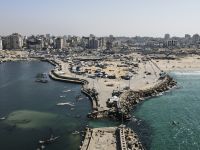In its latest GCC brief, NBK reports, more than a year has passed since the global crisis imposed its toll on GCC banks. With the worst of the global crisis now believed to be behind us, the risks facing most regional banks are ebbing, and we expect a gradual turnaround in banks’ attitude and activity. Despite the strong link and integration with global financial markets, the strong capitalization and financial strength of regional banks, along with generous government support enabled banks to ride out these difficult times at a relatively low cost, and demonstrated their resilience and ability to weather sudden and dramatic shifts in their business environment.
Undoubtedly, the full impact of the crisis on banks varies from one bank to another, yet there has been a common reaction and response by regional banks to the new banking reality: a conservative lending approach, more dependence on government deposits, higher provisioning, cost cutting, and delays of expansion plans.
At the outset, the global crisis led to an exit of foreign liquidity which in turn raised funding costs. Later, the ensuing high uncertainty, slower economic activity and correction in real estate and stock markets, globally and regionally, led to deterioration in banks’ portfolios. Fortunately, there has been no single collapse of any regional bank for a number of reasons including official support and adequate supervision, limited exposure to toxic assets and government readiness to bailout banks facing systemic or even idiosyncratic risks. The soundness and overall strong position of GCC banks can easily be inferred from the strong ratings most banks received from international rating agencies.
Better-than-expected performance given the crisis
However, banks’ buoyant performance of previous years obviously reached a turning point, and some key performance indicators were negatively affected. For example, preliminary data show a drop in profits of GCC banks during the first nine months of 2009 by 16.3% relative to the same 2008 period. The declines range between 5.5% for Qatari banks to 66% for Kuwaiti banks. Banks in Saudi Arabia reported a single digit drop in their profits (-5.8%), while UAE and Oman banks saw a bigger fall at 14.9% and 14.6%, respectively. On the other hand, Bahrain was the only country to see an increase in its banks profits (+368%). This is attributed mainly to the fact that the “Arab Banking Corporation” of Bahrain recorded USD 80 million in net profits in the first nine months of 2009 compared to USD 852 million losses recorded in the same 2008 period.
Chart 1: GCC banks’ net profits after taxes or zakat (USD million)
<?xml:namespace prefix = v ns = "urn:schemas-microsoft-com:vml" />
Source: Zawya
Part of this variance in performance reflects differences in approaches to impairment loans and investments. For example, in Kuwait, the sharp drop in profits is attributed mainly to over provisioning mandated by the central bank. Besides lower profits, banks also saw softer intermediation activity, weak growth in assets and squeezed margins, in addition to changes in balance sheet structures.
Chart 2: GCC banks’ provisions
(USD million)
Source: Zawya
The driving factors included slower economic growth; specific problems encountered by key borrowing sectors such as investment companies, real estate developers, and equity investors, in addition to the drop in interest rates and increased reliance on official sources of funding. A number of GCC banks were also negatively affected by two regional events that took place in 2009, specifically debt repayment problems at the Saad/AlGosaibi conglomerates and Dubai World. Despite the lack of adequate transparency, however, it is widely believed that overall exposure of regional banks to these two events is limited. Estimates suggest that exposure of Saudi Arabia banks to Saad/AlGosaibi is close to USD 5 billion, or 2.5% of their total credit to private sector as of August, 2009. The Central Bank of the UAE announced last November that 13 UAE banks (plus 7 foreign banks operating in the UAE) have total exposure to Saad & Gosaibi worth USD 2.9 billion. Other GCC countries have exposures to this group that range between USD 192 million in Oman to USD 1.3 billion in Kuwait.
With respect to Dubai World, banks in 3 GCC countries (Bahrain, Kuwait, Oman) have a total exposure of less than USD 0.5 billion. Meanwhile, Saudi Arabia announced a limited exposure without giving numbers. On the other hand, exposure of UAE banks is expected to be the largest, though no official numbers have been released.
Overall, 2009 witnessed the emergence of a new operating environment that is set to pressure banks’ performance over the medium term, force a change in their business models, and heighten their focus on risk management as well as risk aversion to levels not seen before. In addition, central banks are enhancing their supervision and adopting tighter regulatory standards. On the other hand, Gulf banks are set to benefit from an improvement in the economic and business environment as well as continued government support. With clean balance sheets and higher provisions already in place, the anticipated performance and indicators of GCC banks in 2010 and over the medium term are expected to improve relative to 2009, though more barriers and risks are expected on the road to recovery. While profits are expected to show solid growth, albeit at a slower pace than that seen in prior years, they will nonetheless be affected by the relative squeeze on margins. Our forecasts are based upon the reasonably solid economic outlook for the region, developments that have taken place in GCC banks’ balance sheets and financial indicators since the onset of the crisis, and the demonstrated strong commitments of Gulf governments to support their respective domestic banks.
Chart 3: GCC banks’ return on assets
(%)
Source: Zawya. 9M09 data are annualized for all countries
Slowdown in credit growth and funding constraints result in sluggish growth in balance sheets
The repercussions of the global financial crisis on regional banks were felt directly in the developments of the balance sheets. After growing at an annual average rate in excess of 25% over the period 2003-2008, GCC banks saw their assets grow at the lowest rates in years. As of August 2009, these assets stood at $ 1.1 trillion, 1.4% higher than their level at end 2008 and 4.2% up y/y. The slowdown in credit growth and limited funding are to blame for this deceleration.
Chart 4: GCC banks' assets growth
(Y/Y %)
Source: GCC central banks
Country-wise, we see an increase in bank assets in all Gulf countries, except in Kuwait and Bahrain, where assets fell by 6.3% and 4.9%, respectively. In Kuwait, however, this drop in assets was purely the result of the Kuwaiti dinar depreciation against the US dollar during this period that amounted to 7%. Kuwait is the only GCC country that pegs its currency to a basket of major currencies dominated by the dollar, while other members of the group peg their currencies to the US dollar. In local currency terms, the assets of Kuwaiti banks were actually up by 0.7% y/y. On the other hand, Qatari banks recorded the highest expansion in assets (+12%) followed by Omani banks (+9%). More recent data published by Qatar, Saudi Arabia and Kuwait (November 2009) show much stronger growth in bank assets from their August levels. In 2010, we expect growth in total assets close to 10%, especially with the anticipated resumption of credit growth at stronger pace than in 2009 as the local economies benefit from the continued expansion in government spending, in addition to the expected rise in banks’ foreign assets.
Focus on commercial banking activities makes lending the main contributor to income and balance sheet size
Credit, especially to the private sector, is the largest component of assets, and a prime source of interest revenues. As of August 2009, data show credit to the private sector accounting for almost half of Gulf banks’ combined assets, up from 40% in 2002. The ratio ranges between 28% in Bahrain, to 63% in Kuwait and 66% in Oman. Furthermore, credit growth has been responsible for slightly more than 50% of the expansion in assets over the last five years, and for two thirds since the start of 2009.
Chart 5: Composition of GCC banks' assets
Source: GCC central banks and NBK calculations
In light of the economic difficulties facing the private sector across the region since late 2008, and the associated escalation in uncertainty, banks justifiably reacted by adopting a more conservative lending approach. Their main focus shifted from maximizing profits to saving their financial health and to maintaining ample precautionary liquidity cushions. This resulted in a significant deceleration in the growth of credit to the private sector. By end-August 2009, outstanding credit facilities extended to the private sector across the six Gulf countries were only 1.9% higher than at end-December 2008.
On a year-on-year basis, the expansion in credit was also modest at 3.8%. These ratios are way below their levels of previous years, when credit growth averaged 30% per annum over the period 2003-2008, up from an average of10% in the four years prior to the start of the recent oil boom. It is worth noting that credit growth was expected to slow down even before the onset of the global crisis as a result of measures adopted by various central banks since late 2007 to curb rising inflationary pressures. For the second half of 2009, however, anecdotal evidence suggests that demand for credit had picked up, but there is the issue of quality of demand. Under such circumstances, banks are expected to target a higher quality of borrowers across the board. With the end of 2009, we expect growth in credit to the private sector to rise from 4.5% in 2009 to 8% in 2010, and 10% per annum over the years 2011 and 2012.
Chart 6: Credit to private sector in the GCC
(Y/Y %)
Source: GCC central banks
By way of summary, and despite their strong integration with global financial markets, the overall impact of the global crisis on GCC banks has been relatively limited and appears to be fading. And though some risk may remain for individual banks, banks, as a sector, are expected to record a solid performance this year and over the medium term. Part 2 of this note will discuss developments in the structure of banks’ balance sheets. ÿ







